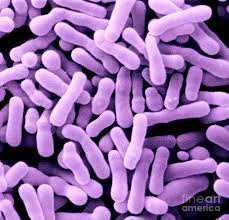Bifidobacterium animalis: Difference between revisions
| Line 38: | Line 38: | ||
==Ecology== | ==Ecology== | ||
symbiosis; biogeochemical significance; contributions to environment.<br> | |||
''Bifidobacterium animalis'' has an ecological habitat that helps make up the colon flora of most mammals. It resides mainly in the large intestine in a pH from 5.5-7. This bacterium is commonly cultured in a MRS broth at 37 degrees Celsius[3]. | ''Bifidobacterium animalis'' has an ecological habitat that helps make up the colon flora of most mammals. It resides mainly in the large intestine in a pH from 5.5-7. This bacterium is commonly cultured in a MRS broth at 37 degrees Celsius[3]. | ||
Revision as of 15:13, 18 April 2018
Classification
Higher Order Classification
Domain: Bacteria
Phylum: Actinobacteria
Class: Actinobacteria
Order: Bifidobacteriales
Family: Bifidobacteriaceae
Species
Bifidobacterium animalis
Description and Significance
Bifidobacterium animalis is a branched, rod-shaped (diplobicillus) gram-positive bacteria. This bacteria is generally found in the large intestines of mammals such as: cats, cows, and humans. Discovered by Henry Tissier in 1900 Bifidobacterium animalis was isolated from a breast-fed infant[1].
Although it was discovered in 1900, research on this bacterium did not ensue until the interest in probiotics in 1950. Probiotics are microorganisms that are ingested either in combination or as a single organism in an effort to normalize intestinal microbiota and potentially improve intestinal barrier function[2]. It has long been speculation that probiotics are useful in alleviating or curing the symptoms associated with irritable bowel syndrome, ulcerative collitis, diarrhea, and atopic dermatitis[3].
Genome Structure
Bifidobacterium animalis contains one circular chromosome consisting of 1, 943, 990 base pairs with a G-C content of 60.5% which is similar to all members of Bifidobacterium[4]. The bacterium carries 1,560 open reading frames (OFRs), 52 tRNA operons, 4 rRNA operons, and a 36 base pair cluster of regularly interspersed short palindromic repeat (CRISPR)[4].
Cell Structure, Metabolism and Life Cycle
Bifidobacterium animalis contains all of the traditional elements of rod-shaped bacteria including organelles, a plasmid, a cell membrane, but not a flagella. Recent studies of the extracellular polysaccharides of the cell envelope have found high RHa residue, which has been postulated to interact with the mucous community of the intestines[3].
Bifidobacterium animalis is an anaerobic chemoorganotroph that undergoes lactic acid fermentation. Lactic acid fermentation is the process by which six-carbon sugars like glucose are converted into cellular energy and lactate in the absence of oxygen[5]. Lactic acid in the intestines is hypothesized to aid in the hydrolysis of lactose which is not easily broken down[6].
Ecology
symbiosis; biogeochemical significance; contributions to environment.
Bifidobacterium animalis has an ecological habitat that helps make up the colon flora of most mammals. It resides mainly in the large intestine in a pH from 5.5-7. This bacterium is commonly cultured in a MRS broth at 37 degrees Celsius[3].
References
[1]Tissier, H. Recherches sur la flore intestinale des nourrissons:(état normal et pathologique) (Doctoral dissertation). 1900.
[2] Ghouri, Yezaz A et al."Systematic Review of Randomized Controlled Trials of Probiotics, Prebiotics, and Synbiotics in Inflammatory Bowel Disease.", Clinical and Experimental Gastroenterology 7. 2014. pp 473–487. PMC. Web. 18 April 2018.
[3] Uemura, Yusuke et al. "Chemical structure of the cell wall-associated polysaccharide of Bifidobacterium animalis subsp. lactis LKM512", Glycoconjugate Journal. November 2014, vol 31, issue 8, pp 555–561. Web. 18 April. 2018.
[4] Bottacini, Francesca et al. "Complete Genome Sequence of Bifidobacterium animalis subsp. lactis BLC1", Journal of Bacteriology. November 2011. vol 193, issue 22, pp 6387-6388. Web. 18 April. 2018.
[5] Robert Bear, David Rintoul, Bruce Snyder, Martha Smith-Caldas, Christopher Herren, Eva Horne, Principles of Biology. OpenStax CNX. May 13, 2016 http://cnx.org/contents/db89c8f8-a27c-4685-ad2a-19d11a2a7e2e@24.18.
[6] Gilliland, Stanley. "Health and nutritional benefits from lactic acid bacteria", ScienceDirect. September 1990. vol 87, issue 1–2, pp 175-188. Web. 18 April 2018.
Author
Page authored by Paul Proctor & Benjamin McKinnon-Duggins, student of Prof. Jay Lennon at IndianaUniversity.

